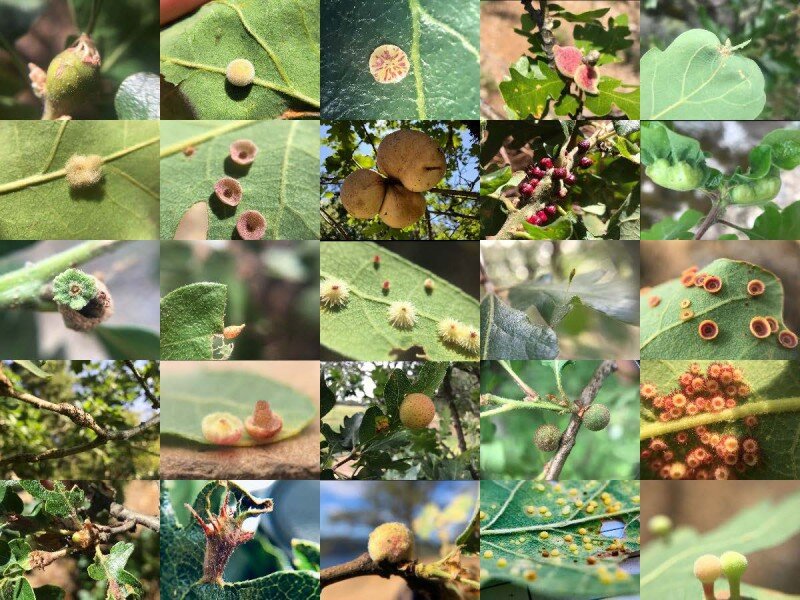A collage of oak galls created by oak gall wasps. Photo credit: Kirsten Prior
Climate change has caused temperatures in the Pacific Northwest to warm, causing some insect species to expand their ranges into more northerly oak savannas, according to a new study from Binghamton University, State University of New York.
Side by side, Dylan Jones showed photos of two oak leaves. One was healthy and green, occasionally riddled with galls, a structure made by a herbivorous species of oak gall wasp. The other leaf was yellowed and tattered, the victim of an insect population without predatory control and control. Climate change has caused warming in the Pacific Northwest and caused species like Neurotereus saltatorius to expand their range into more northerly oak savannas.
“In the native range, you may find a handful of galls on a single leaf. In the extended range, you can sometimes find thousands on a single tree,” said Kirsten Prior, assistant professor of biological sciences. “It’s pretty common all over Vancouver Island.”
Jones, a Binghamton University graduate student in life sciences and a Clifford D. Clark Diversity Fellow, is the lead author of a recently published research paper Journal of Animal Ecology on the situation. Co-authors of “Latitudinal Gradient in Biodiversity Offers High Niche Opportunity for a Range-Extending Phytophagous Insect” include Prior, field technician Julia Kobelt, then-student Jenna Ross, and assistant professor of biological sciences Thomas Powell.
Oak savannas are grass and shrub areas where oak is the dominant tree species. The species of oak in question – Quercus garryana – needs a dry environment. As a result, oak savannahs are often found in the rain shadow of the west coast mountain range, Prior explained.
A diverse and ecologically important group of trees found throughout North America, live oaks are home to a wide variety of insect species such as B. Oak gall wasps. These wasp species form growths known as galls, which can come in a variety of shapes, from those resembling large apples to others with brightly colored spines resembling sea urchins.
Interestingly, Alfred Kinsey – yes, that Kinsey – studied oak gall wasps before switching his field of study to human sexuality.
“Biologists and amateurs have long been fascinated by this group of species because they’re quite charismatic,” Prior said. “You can walk up to an oak tree and see all these structures on it.”
In addition to their herbivorous creators, these galls house other insect species, including a dazzling variety of parasitoid wasps, one of the most diverse and ecologically important groups in the animal kingdom, the latter for their role in controlling insect pests. Ichneumon wasps lay their eggs in the gall; after hatching, their larvae then eat the larvae of the oak gall wasp.
Oak gall wasps are very diverse in North America but are not well documented. Their evolutionary relationships and even the identification of some species remain unknown. A consortium of scientists across the continent is working to change that; Jones and Prior are part of that effort.
“It is important to continue to document biodiversity. We still haven’t described a good part of the biodiversity on Earth, especially in insects,” Prior said.
ecosystem invaders
Over the course of this summer, the researchers reviewed their study sites on three separate occasions. Some were quite remote, requiring travel on unpaved logging roads, or located on Bureau of Land Management properties or conservation areas associated with Indigenous communities. Others were suburban and only a short trip from the cities.
Due to urbanization, few oak savannas remain on Vancouver Island. those that remain are highly documented and maintained by landowners.
“We have longstanding relationships with many landowners there that allow us to work on their property,” Prior said. “Some of them are so excited to have researchers there.”
Biodiversity tends to work on a latitude gradient, Jones added: The closer you are to the equator, the more species there are. A similar situation applies when it comes to higher altitudes. If a species is able to expand its range due to rising temperatures, it can advance into areas without a variety of predators and competitors, and eventually overwhelm the ecosystem.
The case of the oak gall wasp highlights the importance of biodiversity and the potential long-term impacts of climate change, the researchers point out.
“Biodiversity can be really important in potentially protecting areas from invading species,” Jones said. “If we have strong competitors and predators, it could make areas less vulnerable to invading species.”
A crypt warden wasp has been found to parasitize several species of gall wasps
The latitudinal gradient in species diversity offers large niche opportunities for a range-extending phytophagous insect. Journal of Animal Ecology (2022). DOI: 10.1111/1365-2656.13780
Provided by Binghamton University
Citation: Climate Change Leads to Expansion of Invasive Insects on US West Coast (2022, August 10) Retrieved August 10, 2022 from https://phys.org/news/2022-08-climate-invasive-insect-expansion-west .html
This document is protected by copyright. Except for fair trade for the purpose of private study or research, no part may be reproduced without written permission. The content is for informational purposes only.
#Climate #change #leading #proliferation #invasive #insects #West #Coast


Leave a Comment